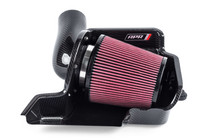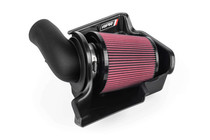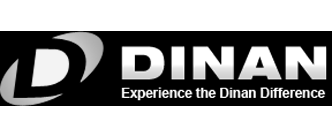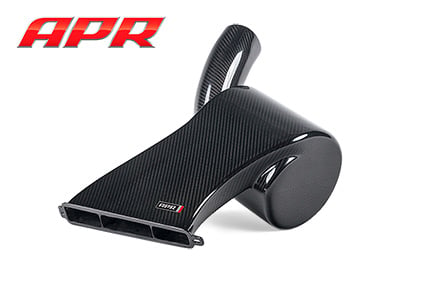
The APR Carbon Fiber Intake System is an attractive high performance upgrade for the latest 1.8T and 2.0T engines as found in various MQB platform vehicles.
The factory intake design has the foundation for excellent performance, but much of this is sacrificed in an effort to meet other design requirements. With requirements set forth for only supporting factory power output levels, low engine sound levels and long service intervals, there is plenty of room for improvement.
The APR Carbon Fiber Intake System increases performance primarily by improving mass airflow through the system while still proving adequate filtration. Expect greater horsepower and torque through the power band with a more direct and responsive feel upon pressing the throttle. Sounds from the engine and turbocharger are enhanced and some may even experience better fuel economy depending on driving style.
Research and Development
Uncommon to most in the market today, APR spared no expenses during the research and development period. For the better part of a year, APR’s Mechanical Engineers created several prototype intake designs utilizing our in house Sterolithography 3D printer and other rapid prototyping techniques. Various filter mediums were tested in conjunction with the new intake designs through simulated models, flow bench analysis, dyno data collection and in real world applications all in an effort to derive the best possible solution.
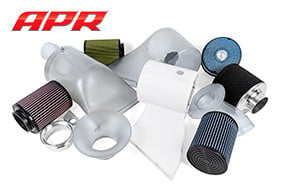
Collection of various test pieces.
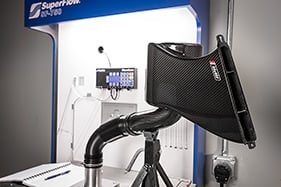
Flow Bench Testing
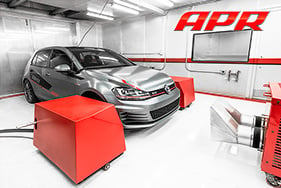
Dyno Testing
Engineering and Design Information
To increase performance over the factory intake system, the intake system’s ability to flow a higher mass of air is critical. In order to achieve this, APR’s Mechanical Engineers focused on improving the pressure ratio between the inlet and outlet of the intake system, reducing turbulence, maximizing filter efficiency and keeping IAT as low as possible.
Intake Filter Flow Bench Analysis
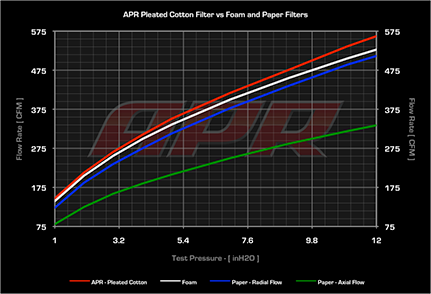
Intake housing Flow Bench Analysis
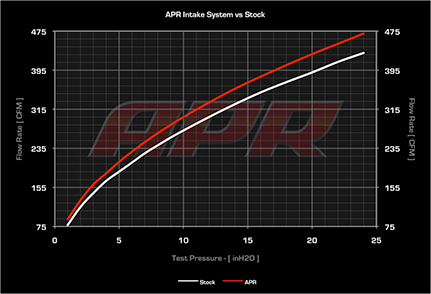
Improving the Pressure Ratio
In an effort to strive for an ideal pressure ratio (1:1) between the intake’s inlet and outlet, the intake features several key characteristics:
Volute Filter Chamber
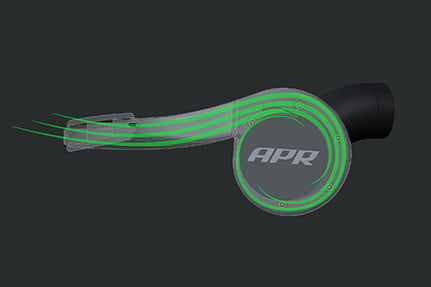
Through CFD optimization and flow-bench validation, the intake’s filter housing was shaped into a reducing spiral, or volute, which uses the inertia of the air entering the system to increase pressure on the outside of the filter. This creates an even pressure distribution across the entire face of the filter, rather than only a few key spots, and as such, maximizes utilization of the filtration element.
Compared to many other popular intake styles, the APR intake system allows for the use of a small, compact filter with better filter utilization as systems often twice its size.
High Pressure Inlet Snorkel and Sealed Design
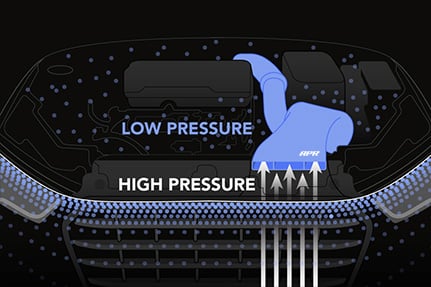
Unlike traditional open element filters, the APR intake design only pulls air from the grille area near the leading edge of the vehicle’s hood. In doing so, it draws air from an area of relatively high pressure. As the vehicle increases in speed, pressure continues to build and ultimately aids in the intake’s effectiveness.
By sealing the intake system, pressure created during the ram air effect and volute design is not simply lost within the engine bay. This is contrary to open element filters that pull air from a relatively low pressure region formed within the engine bay.
Reducing Turbulence
Flow disruptions and turbulence ultimately impede airflow to and from the intake filter, resulting in a performance loss. The APR Intake system takes a two-step approach to improving mass airflow in this region.
Directional Turning Vanes
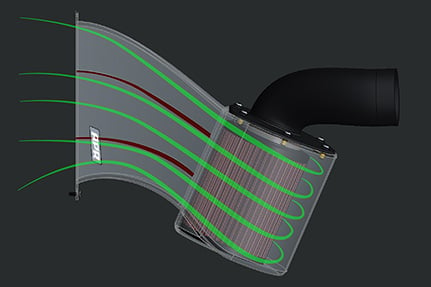
As air enters the intake entrance, directional vanes ensure airflow is properly directed towards the entire length of the intake filter rather than only a small portion. This results in a reduction of air turbulence and creates an even pressure distribution over the entire filter surface for maximum filter efficiency. As the filter becomes dirty with age, performance drop happens less dramatically as particles form evenly over a larger portion of the intake rather than localizing to one location or another.
Surface Roughness
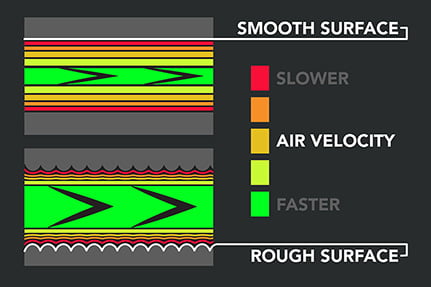
When air flows through a smooth pipe, the speed at which the air flows is slower along the pipe’s smooth walls than is in the center of the pipe. Ultimately this results in a boundary layer that effectively reduces the cross-sectional area of the free flowing portion of the pipe, and creates drag. To minimize this effect as much as possible, the intake’s inner surface is kept mildly rough during the manufacturing process. As such, a thinner turbulent boundary layer forms, which ultimately prevents the boundary layer from growing larger as flow increases.
Intake Air Temperature Management
Intake air temperature (IAT) plays a critical role in engine performance, especially on turbocharged engines where the ambient air temperature is raised twice through both compression via the turbocharger, and then again during the engine’s compression stroke.
In an effort to maintain the lowest possible starting IAT, the APR Intake system begins by drawing air from the coldest possible location, which is the front end of the vehicle before the radiator. Air travels a short path through the intake system, past the filter and on its way to the turbocharger through a sealed intake design that prevents ingestion of hot, under-hood air. Finally, the intake’s carbon composite design features a thin fiberglass backing, which improves thermal insulative properties.
NOTE: Unlike many intake designs with a full frontal scoop, the APR system does NOT block the factory engine cooling duct found on the opposite side of the factory intake system.
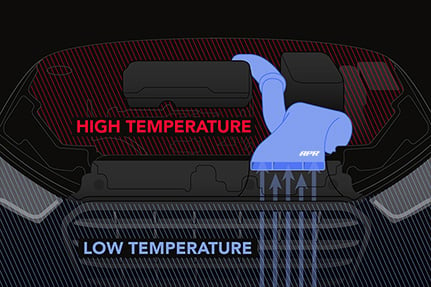
Filtration
APR’s design requirements called for an intake filter medium that exhibited high flow capabilities, long service life and adequate filtration properties. While traditional paper filters and even some foam filters can achieve one or more of these requirements, only a pleated cotton filter was able to achieve all three. This is due in part to the intake housing’s volute design and turning vanes. With even pressure flow distribution across the entire filter element, the filter is loaded more evenly, retaining performance over time, increasing the length of the maintenance intervals, and increasing the filter's effectiveness.
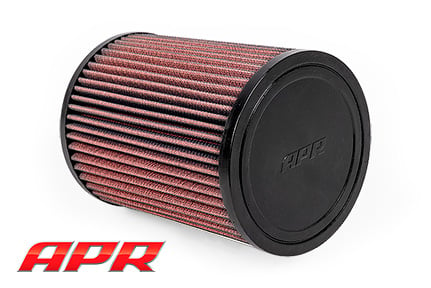
Sound
In an effort to please customers unaware of the sounds caused by turbocharging an engine, as well as cross platform use on both economy and performance oriented vehicles, the OEM was tasked with creating an intake that many would consider to be too quiet for a performance vehicle. APR’s design requirements called for an intake system that only delivered the engine’s true turbocharged sound as air is sucked through the turbocharger or exhausted from the diverter valve upon lifting off the throttle. The inherent stiffness of carbon fiber composite material results in an induction resonance from the engine allowing the occupants to hear a clean and crisp intake note without being overbearing or cheap sounding in nature.
Appearance
Upon opening the hood, it’s clear to see why the APR Carbon Fiber Intake System is so highly sought after. Featuring a carbon fiber 2x2 weave common to the engine bays of Audi’s high end of Quattro GMBH vehicles, the intake demands attention and delivers form that matches the intake’s function despite playing a secondary role in the design requirements.
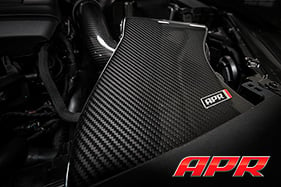
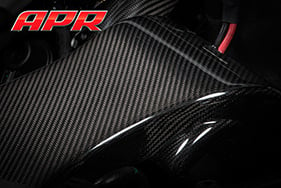
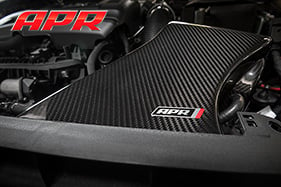
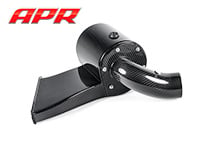
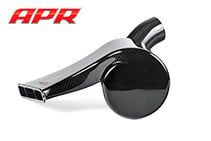
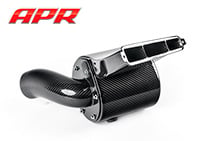
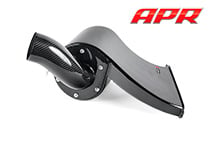
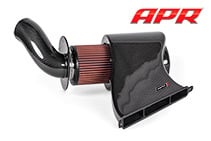
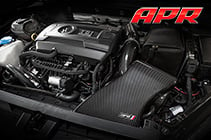
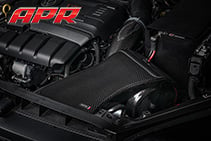
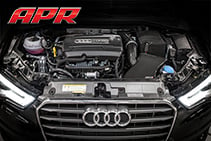
Installation
The intake system comes preassembled from APR ready to be installed in minutes with minimal tools. With the factory unit removed, the intake slips into place and connects to the factory turbo inlet pipe using the OEM hardware without filling the engine bay with additional couplers and hose clamps. Because the system fits in the OEM location, it’s fully compatible with future upgrades from APR, including our larger Stage III Turbocharger Systems.
Dyno Results
- APR Intake vs Stock
- APR Intake gain over Stock
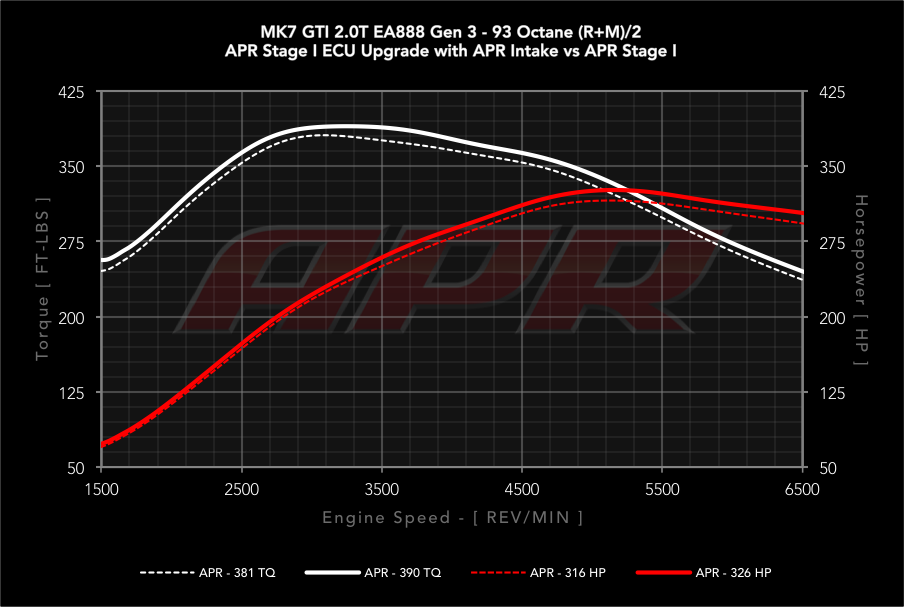
Optional Accessories
Turbo Inlet Pipe
The APR Carbon Fiber Turbo Inlet Pipe replaces the rear factory plastic accordion tube with an attractive carbon fiber inlet, complementing the APR Intake System’s aesthetically pleasing design. The intake and inlet hose are joined via a necessary flex coupler to allow for adequate engine movement under use without damaging the intake. The turbo inlet pipe is completely compatible with all factory turbochargers and APR’s Stage III Turbocharger System.
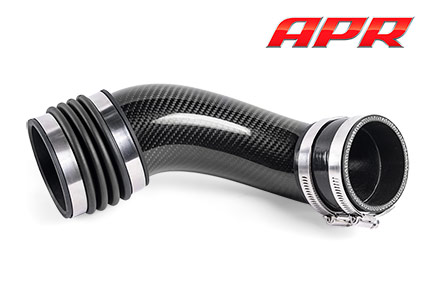
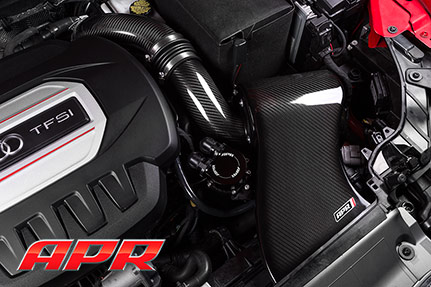
CAUTION: The engine moves substantially under load and as such the factory turbo inlet pipe and APR turbo inlet pipe flexes. Replacing this pipe with a non-flexible silicone hose will damage the intake. Doing so is not recommended and voids the intake’s warranty.
Coolant Hose
The factory coolant hose is designed to be routed over the top of the intake system. However, when routed underneath the intake, it’s far more aesthetically appealing. The APR coolant hose replaces the factory unit and routes cleanly under the intake and around the APR catch can without kinking or adding extra stress to the mounting points.
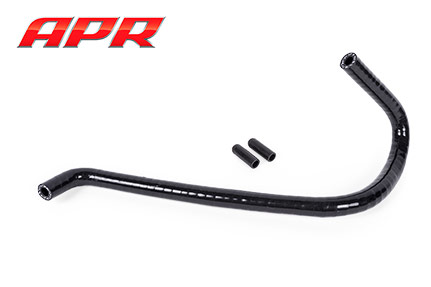
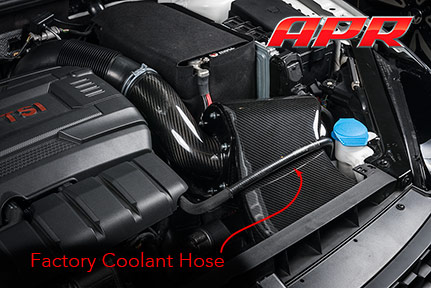
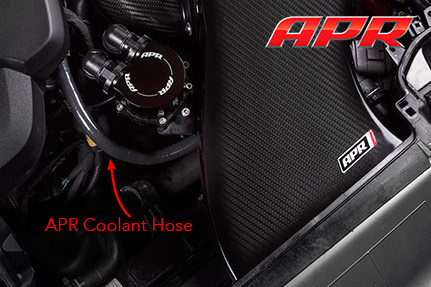
Secondary Air Injection (SAI) Filter
For Vehicles equipped with secondary air injection (SAI), an SAI filter is required.
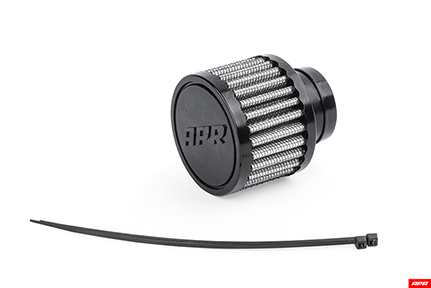
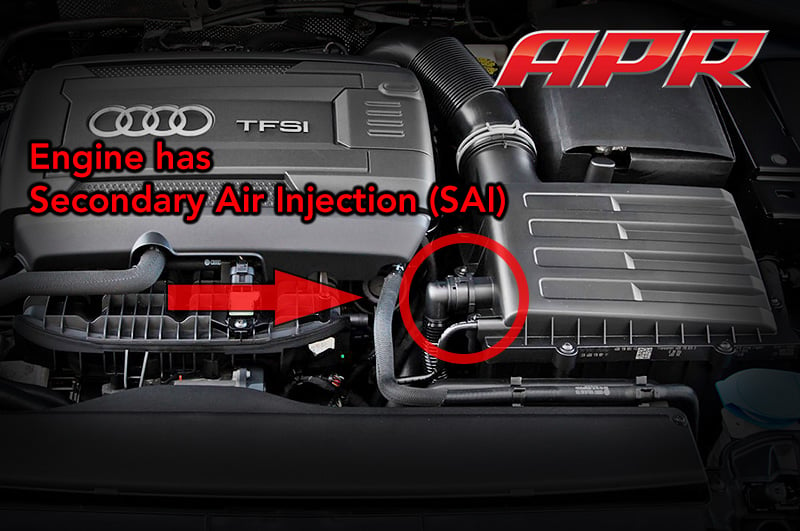
TT Adapter Kit
The Audi TT and TTS requires the adapter below.
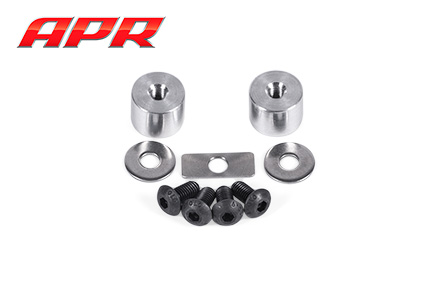
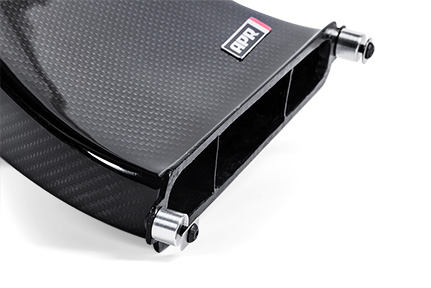
Returns Policy
Returns are accepted within 15 days of delivery date. Items are not eligible for return if they are: used, altered, damaged, or not in original packaging. All returns are subject to a 20% fee. Special orders are non-refundable. No refunds on electrical parts. We'll also pay the return shipping costs if the return is a result of our error (you received an incorrect or defective item, etc.).
Part warranties are through the manufacturer only, not Automotive Performance Tuning, LLC(APTuning). Customer is responsible for any applicable labor charges on warranted parts.
If you need to return an item, simply login to your account, view the order using the "Complete Orders" link under the My Account menu and click the Return Item(s) button. We'll notify you via e-mail of your refund once we've received and processed the returned item.
Shipping
We can ship to virtually any address in the world. Note that there are restrictions on some products, and some products cannot be shipped to international destinations.
When you place an order, we will estimate shipping and delivery dates for you based on the availability of your items and the shipping options you choose. Depending on the shipping provider you choose, shipping date estimates may appear on the shipping quotes page.
Please also note that the shipping rates for many items we sell are weight-based. The weight of any such item can be found on its detail page. To reflect the policies of the shipping companies we use, all weights will be rounded up to the next full pound.














